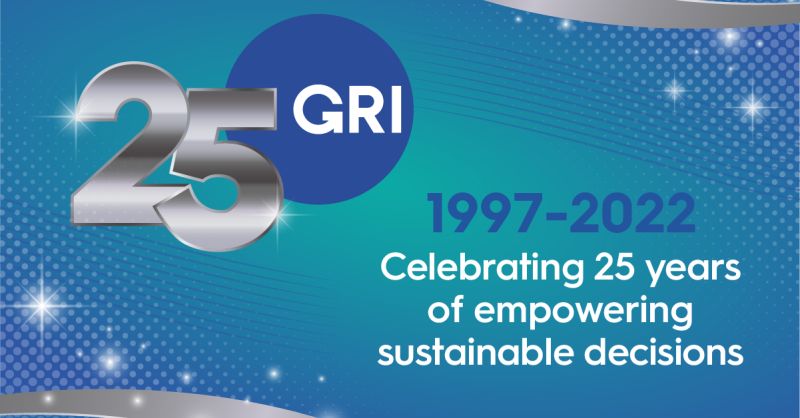In this period (August/September), I wanted to delve into the subject of GRI standards because I consider them a very important tool for assessing the starting performance and subsequently the improvement or deterioration of the activity we are analysing.
The Global Reporting Initiative (GRI) is an international non-profit organisation founded in 1997 in Boston to define standards for reporting on sustainable performance (also known as social reporting) of companies and organisations of any size belonging to any sector and country in the world.
The GRI standards are free of charge, usable by all and accompanied by explanations, only very specific courses are chargeable.
The standards are not very simple at first glance, but in my opinion, the best way to approach them is to
- analyse a document in which the standards are present,
- check that you understand the theory by following the different steps of the guidelines provided,
- test your understanding by starting to draft the report for your activity.
Currently, I am proceeding with the first two steps, the third point takes more time, and I want to do it for my hotel to get a practical approach.
The document I have decided to analyse is the ENEL sustainability report, not because I necessarily believe what it says, but because among those I have found available on the GRI website, it is one of the most understandable and written in Italian.
I start with the report’s structure to understand which GRI criteria are included. The complete file is available and can be downloaded here (scroll down to see the files ready for the download. https://www.enel.com/investors/sustainability

Structure of the report: part one
The first part of the report presents the typical elements that present the activity of a company.
- Title
- Letter to stakeholders (GRI 102-14 Statement by a senior manager)
- Summary Infographic
- Index
Company view (at a glance) includes:
The business model (resources, outputs) and value created
The governance of sustainability
ESG integrated into business management
ENEL’s governance model for sustainability and participation in associations
Sustainable finance, sustainability ratings and indices
ESG ratings,
ESG indices and Targets achieved in the reporting year (2020 for this report))
Our priorities and stakeholder involvement
The context in which we are
Main types of risk
The priorities identified
Stakeholder engagement
Our sustainability strategy and contribution to sustainable development goals
Energy transition
Centrality of people
ESG foundations
Growth Accelerators
In this section, the GRI criteria found inside the report are
| 102-5 | Ownership and legal form |
| 102-6 | Markets served |
| 102-7 | Size of the organisation |
| 102-15 | Key Impacts, Risks and Opportunities |
| In my opinion also | |
| 102-12 | Statement by a senior executive in letter to stakeholders |
| 201-1 | economic value directly generated and distributed |
| 303-3 303-5 | water withdrawal water consumption |
| 305-1 | Direct GHG emissions (scope1) |
| 401-1 404-1 | New hires and turnover The average hour of training per employee per year. |
The criteria can be found online in Italian (2016 version for the moment) and English version 2020. Click here to download the version most appropriate for you.

Structure of the report: part two
The second, most information-intensive part, deals with ESG performance
Energy transition
NET ZERO AMBITION
A just and inclusive transition
Stakeholder engagement in the fight against climate change;
Enel’s climate advocacy activities;
Enel’s governance model to tackle climate change;
Enel’s impact on climate change
Climate scenarios
The strategy for tackling climate change
Main risks and opportunities related to climate change
Enel’s performance in tackling climate change.
ELECTRIFICATION, DIGITAL AND PLATFORMS
Operational excellence and quality in distribution
Service quality and promotion of responsible and conscious consumption
The centrality of people
OUR PEOPLE
Enel people around the world and the Open Power model;
Connected and close: smart working and caring during emergencies;
Investing in our people;
Listening and dialogue
Diversity and inclusion;
Gender gap and gender pay gap: our action plan
Caring for all
Supplementary healthcare and supplementary pensions
Industrial relations.
LOCAL AND GLOBAL COMMUNITIES
Strategy and shared value creation model
Value for countries and territories
Contribution to sustainable development objectives
The LBG method
Some examples of sustainability projects
Enel Heart
Access to energy
Main ongoing development projects and resettlement management
Growth accelerators
INNOVATION
Technologies and Innovability®
The Open Innovability® ecosystem
Innovating frontier technologies: Innovation Communities
Creating value in the future: intellectual property
Innovation starts with you: a new culture
The main programmes
DIGITAL MEDIA AND CYBER SECURITY
Digital Transformation
Cyber security
CIRCULAR ECONOMY
The governance of the circular economy
Circular activities of the Business Lines and main projects
Circular Open Meter
Targets and performance indicators
Circular City
Ecosystem involvement
A new circular culture
ESG foundations
SUSTAINABLE SUPPLY CHAIN
Purchasing and procurement of goods and services
Fuel procurement
OCCUPATIONAL HEALTH AND SAFETY
The health and safety system
Performance 2020
Safety in procurement processes
Infrastructure safety and technological innovation
Health
Development of safety culture: training and information
Safety of communities and third parties
Emergency management
Nuclear policy
Industrial relations on health and safety issues
ENVIRONMENTAL SUSTAINABILITY
Environmental governance
Emissions
Energy
Water
Waste
Soil, subsoil and groundwater
Biodiversity
ROBUST GOVERNANCE
Corporate governance model.
In this section, the GRI criteria are answered according to the ENEL report
| 102-5 102-7 102-9 102-10 102-11 102-12 102-13 102-15 102-16 | Ownership and legal form Size of organisation Supply chain Significant changes to the organisation and its supply chain Precautionary principle Statement by senior management in a letter to stakeholders Memberships in associations. Key impacts, risks and opportunities Values, principles, standards and norms of behaviour |
| 102-17 102-18 102-19 102-20 102-21 102-22 102-23 102-24 102-25 102-26 | Mechanisms for seeking advice and raising concerns regarding ethical issues; Governance Structure; Delegation of Authority; Executive-level accountability for economic, environmental, and social issues; Stakeholder Consultation on Economic, Environmental, and Social Issues; Composition of the highest governance body and its committees; Chairman of the highest governance body; Appointment and Selection of the highest governance body; Conflicts of Interest; Role of the Highest Governance Body in Establishing Purposes, Values and Strategies. |
| 102-27 102-28 102-29 102-30 102-31 102-32 102-33 102-35 102-36 102-37 102-42 102-43 102-44 | Collective knowledge of the highest governing body Performance Evaluation of the Highest Governance Body Identifying and Managing Economic, Environmental and Social Impacts Effectiveness of Risk Management Processes Review of economic, environmental, and social issues Role of the highest governance body in sustainability reporting Communication on critical issues Remuneration policies Process for determining remuneration Stakeholder Involvement in Remuneration Identifying and Selecting Stakeholders Ways of involving stakeholders Key issues and criticisms raised |
| 103-2 103-3 | The management mode and its components Assessment of the management mode |
| 201-2 203-1 205-1 205-2 205-3 | Financial implications and other risks and opportunities due to climate change Infrastructure investments and financed services Operations assessed for corruption risks Communication and training on anti-corruption policies and procedures 3 Established incidents of corruption and actions taken. |
| 302-1 302-3 302-4 303-1 303-2 303-3 303-5 304-4 | Energy consumed within the organisation Energy intensity Reduction in energy consumption Interaction with water as a shared resource Management of impacts related to water discharge Water withdrawal Water consumption Species listed on the IUCN Red List and national lists that find their habitat in the organisation’s areas of operation |
| 305-1 305-2 305-3 305-4 305-7 306-3 307-1 308-1 | Direct GHG emissions (scope1) Indirect GHG emissions from energy consumption (Scope 2) Other indirect GHG emissions (Scope 3) The intensity of GHG emissions Nitrogen oxides (NOX), sulphur oxides (SOX) and other significant emissions Significant spills Non-compliance with environmental laws and regulations. New suppliers assessed using environmental criteria. |
| 401-1 401-2 402-1 403-1 403-2 403-3 403-4 403-5 403-6 403-7 403-9 | New hires and turnover; Benefits provided for full-time employees, but not for part-time or fixed-term employees; Minimum notice period for operational changes; Occupational health and safety management system; Hazard identification, risk assessment and accident investigation Occupational health services. Worker participation and consultation and communication on health and safety at work; Worker training in occupational health and safety; Worker health promotion; Prevention and mitigation of occupational health and safety impacts within business relations Accidents at work. |
| 404-1 404-3 405-1 405-2 406-1 407-1 408-1 409-1 411-1 412-1 412-2 413-1 413-2 414-1 416-1 417-1 418-1 | Average hour of training per employee; Percentage of employees receiving periodic performance and professional development evaluations; Diversity in governing bodies and among employees; The ratio of basic salary and remuneration of women to men; Incidents of discrimination and corrective measures taken; Activities and suppliers where the right to freedom of association and collective bargaining may be at risk; Activities and suppliers at significant risk of incidents of child labour; Businesses and suppliers are at significant risk of incidents of forced or compulsory labour; Incidents of violation of the rights of indigenous peoples; Activities that have been the subject of human rights audits or impact assessments; Training employees on human rights policies or procedures; Activities involving local community involvement, impact assessments and development programmes; Activities with significant current, potential and negative impacts on local communities; New suppliers are assessed using social criteria; Assessment of health and safety impacts by product and service category; Information and labelling requirements for products and services; Proven complaints regarding breaches of customer privacy and loss of customer data. |

Structure of the report: part three
Part Three sets out the Trend Topics
FISCAL TRANSPARENCY: APPROACH TO TAXES
Tax governance, control and risk management
Transparent stakeholder relations
Reporting
The European Taxonomy
Green Bond Report 2020 – accompanying notes
In this section, the GRI criteria are answered according to the ENEL report
207-1 Approach to taxation
207-2 Fiscal governance, control and risk management
207-3 Stakeholder engagement and management of tax concerns
207-4 Country-by-country reporting.
The fourth part consists of the appendix. This section contains the indices as well as the methodological note and the auditors’ report and sustainability performance indicators.
- methodological note and the auditors’ report
- How this document was constructed
- Analysis of the 2020 priorities
- Identification of issues and stakeholders
- Allocation of priorities to stakeholders
- Evaluation of theme priorities assigned by stakeholders
- Evaluation of theme priorities in corporate strategies in relation to impacts generated
- Linking the themes in the priority analysis to the GRI Standards.
- The reporting process
- Drafting and assurance
- Report parameters.
- Sustainability statement: the performance indicators.
The key indicators are shown in the table as a fundamental part and consequently cover the same topics as the second section. In addition to this, there are indices for all the criteria used:
- GRI Content Index
- SASB Content Index
- TCFD Content Index
- WEF Content Index.
| 101 | Reporting principles for following the basic process for preparing a sustainability report |
| 102-1 102-3 102-5 102-10 102-32 102-40 102-42 102-43 102-45 102-46 102-47 102-48 102-49 102-50 102-51 102-52 102-53 102-54 102-55 102-56 | Name of organisation Location of head office Ownership and legal form Significant changes in the organisation and its supply chain Role of the highest governance body in sustainability reporting List of stakeholder groups Identification and selection of stakeholders Ways to engage with stakeholders Stakeholders included in the consolidated financial statements Defining Report Content and Topic Perimeters List of Material Issues Review of disclosures Changes in Reporting Reporting Period Date of most recent report Reporting Periodicity Contact information for inquiries regarding the report Statement on reporting in accordance with GRI Standards Index of GRI content External Assurance |
| 103-1 | Explanation of material topic and boundary |

Some important general indications
For the criteria mentioned, we always find similar indications
102-2 Activities, brands, products and services
The organisation must report the following information
- a description of the organisation’s activities
- the main brands, products and services, including an explanation of any products or services that are prohibited in certain markets.
Reporting recommendations
1.1 In reporting the information specified in Statement 102-2-b, the organisation should also explain whether it sells products or services that are the subject of stakeholder or public debate.
This is because as required by the “defining the content of the report” guidelines there are some basic principles of proper content for the report:
- Relevant topics identified by involving stakeholders;
- Assess the relevance of the indicators for the identified topics;
- Use available tests to understand whether we have said everything, i.e. whether the information is complete;
- The principle of prioritisation should be used to establish the importance and order of inclusion of topics;
- The methods and processes used to assess relevance must:
- Be specific and customisable for each organisation;
- Always take into account the instructions and tests included in the reporting principles.
The best approach in my opinion is to start from the existing report, if any, or to work by drafts taking inspiration from those who produce one. For this motive I wanted to include the latest available ENEL report.
A comparison with the index of your activity report can immediately indicate if there are topics that you have not included at all. Understanding why this inclusion was not there is very important to assess how to improve it and how to integrate it with the GRI criteria.
Suppose you take the first steps in writing the report for your business. In that case, the GRI criteria provide a very useful indication: indicate for whom the report is mainly intended and report 60/70% of the useful information for these people (for this target group). In general, these are the stakeholders who invest in the business (investors, shareholders, customers, employees); the remaining information included 30/40% should concern the non-direct stakeholders or more generally those with a less direct interest but who have every right to know and be aware of the company’s improved or worsened impacts (positive or negative). They can be, for example, communities and residents of the area where the company’s activities take place.
In the case of Hotel Loveno accommodation SNC, the direct stakeholders are:
Shareholders: Paolo and I, our family ;
Customers: Our guests;
Employees: our employees.
Non-direct stakeholders:
PromoMenaggio Association to which we are members and contributed to restoring during 2020 and 2021.
The municipality of Menaggio considers only the payments made to the municipality for waste disposal, the contribution paid through the tourist tax by our guests and by ourselves as a business.
Residents of Menaggio may benefit indirectly from our activity: businesses and restaurants for example, potential new customers. A bar open in the Loveno area for those passing through. Job opportunities and/or seasonal collaboration. A potential sponsor for social, recreational, or ecological activities close to our sensibility.
Working on a GRI report takes time and energy, so this is one of my goals for the 2023 season at the hotel.

Main source of information in English
Global Reporting https://www.globalreporting.org/standards
https://www.globalreporting.org/media/ukgpbiqx/linking-the-gri-standards-and-cass-csr-40-english.pdf
Sara – tourism sector consultant
